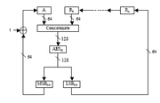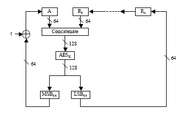
Key Wrap
Encyclopedia
Key Wrap constructions are a class of symmetric encryption algorithms designed to encapsulate
(encrypt) cryptographic key material. The Key Wrap algorithms are intended for applications such as (a) protecting keys while in untrusted storage, or (b) transmitting keys over untrusted communications networks. The constructions are typically built from standard primitives such as block cipher
s and cryptographic hash function
s.
Key Wrap may be considered as a form of key encapsulation
algorithm, although it should not be confused with the more commonly known asymmetric (public-key) key encapsulation
algorithms (e.g., PSEC-KEM). Key Wrap algorithms can be used in a similar application: to securely transport a session key by encrypting it under a long-term encryption key.
(NIST) posed the "Key Wrap" problem: to develop secure and efficient cipher-based key encryption algorithms. The resulting algorithms would be formally evaluated by NIST, and eventually approved for use in NIST-certified cryptographic modules. NIST did not precisely define the security goals of the resulting algorithm, and left further refinement to the algorithm developers. Based on the resulting algorithms, the design requirements appear to be (1) confidentiality, (2) integrity protection (authentication), (3) efficiency, (4) use of standard (approved) underlying primitives such as the Advanced Encryption Standard
(AES) and the Secure Hash Algorithm (SHA-1), and (5) consideration of additional circumstances (e.g., resilience to operator error, low-quality random number generators). Goals (3) and (5) are particularly important, given that many widely deployed authenticated encryption
algorithms (e.g., AES-CCM) are already sufficient to accomplish the remaining goals.
 Several constructions have been proposed. These include:
Several constructions have been proposed. These include:
Each of the proposed algorithms can be considered as a form of authenticated encryption
algorithm providing confidentiality for highly entropic
messages such as cryptographic keys. The AES Key Wrap Specification, AESKW, TDKW, and AKW1 are intended to maintain confidentiality under adaptive chosen ciphertext attacks, while the AKW2 algorithm is designed to be secure only under known-plaintext (or weaker) attacks. (The stated goal of AKW2 is for use in legacy systems and computationally limited devices where use of the other algorithms would be impractical.) AESKW, TDKW and AKW2 also provide the ability to authenticate cleartext "header", an associated block of data that is not encrypted.
Rogaway
and Shrimpton evaluated the design of the ANSX9.102 algorithms with respect to the stated security goals. Among their general findings, they noted the lack of clearly stated design goals for the algorithms, and the absence of security proofs for all constructions.
In their paper, Rogaway
and Shrimpton proposed a provable key-wrapping algorithm (SIV--
the Synthetic Initialization Vector mode) that authenticates and encrypts an arbitrary string and authenticates,
but does not encrypt, additional data which can be bound into the wrapped key. This has been standardized as a
new AES mode in RFC 5297.
Key encapsulation
Key encapsulation mechanisms are a class of encryption techniques designed to secure symmetric cryptographic key material for transmission using asymmetric algorithms. In practice, public key systems are clumsy to use in transmitting long messages. Instead they are often used to exchange...
(encrypt) cryptographic key material. The Key Wrap algorithms are intended for applications such as (a) protecting keys while in untrusted storage, or (b) transmitting keys over untrusted communications networks. The constructions are typically built from standard primitives such as block cipher
Block cipher
In cryptography, a block cipher is a symmetric key cipher operating on fixed-length groups of bits, called blocks, with an unvarying transformation. A block cipher encryption algorithm might take a 128-bit block of plaintext as input, and output a corresponding 128-bit block of ciphertext...
s and cryptographic hash function
Cryptographic hash function
A cryptographic hash function is a deterministic procedure that takes an arbitrary block of data and returns a fixed-size bit string, the hash value, such that an accidental or intentional change to the data will change the hash value...
s.
Key Wrap may be considered as a form of key encapsulation
Key encapsulation
Key encapsulation mechanisms are a class of encryption techniques designed to secure symmetric cryptographic key material for transmission using asymmetric algorithms. In practice, public key systems are clumsy to use in transmitting long messages. Instead they are often used to exchange...
algorithm, although it should not be confused with the more commonly known asymmetric (public-key) key encapsulation
Key encapsulation
Key encapsulation mechanisms are a class of encryption techniques designed to secure symmetric cryptographic key material for transmission using asymmetric algorithms. In practice, public key systems are clumsy to use in transmitting long messages. Instead they are often used to exchange...
algorithms (e.g., PSEC-KEM). Key Wrap algorithms can be used in a similar application: to securely transport a session key by encrypting it under a long-term encryption key.
Background
In the late 1990s, the National Institute of Standards and TechnologyNational Institute of Standards and Technology
The National Institute of Standards and Technology , known between 1901 and 1988 as the National Bureau of Standards , is a measurement standards laboratory, otherwise known as a National Metrological Institute , which is a non-regulatory agency of the United States Department of Commerce...
(NIST) posed the "Key Wrap" problem: to develop secure and efficient cipher-based key encryption algorithms. The resulting algorithms would be formally evaluated by NIST, and eventually approved for use in NIST-certified cryptographic modules. NIST did not precisely define the security goals of the resulting algorithm, and left further refinement to the algorithm developers. Based on the resulting algorithms, the design requirements appear to be (1) confidentiality, (2) integrity protection (authentication), (3) efficiency, (4) use of standard (approved) underlying primitives such as the Advanced Encryption Standard
Advanced Encryption Standard
Advanced Encryption Standard is a specification for the encryption of electronic data. It has been adopted by the U.S. government and is now used worldwide. It supersedes DES...
(AES) and the Secure Hash Algorithm (SHA-1), and (5) consideration of additional circumstances (e.g., resilience to operator error, low-quality random number generators). Goals (3) and (5) are particularly important, given that many widely deployed authenticated encryption
Authenticated encryption
Authenticated Encryption is a block cipher mode of operation which simultaneously provides confidentiality, integrity and authenticity assurances on the data. It became readily apparent that securely compositing a confidentiality mode with an authentication mode could be error prone and difficult...
algorithms (e.g., AES-CCM) are already sufficient to accomplish the remaining goals.

- AES Key Wrap Specification (November 2001)
- American Standards Committee ANSX9.102, which defines four algorithms:
- AESKW (a variant of the AES Key Wrap Specification)
- TDKW (similar to AESKW, built from Triple DESTriple DESIn cryptography, Triple DES is the common name for the Triple Data Encryption Algorithm block cipher, which applies the Data Encryption Standard cipher algorithm three times to each data block....
rather than AES). - AKW1
- AKW2
Each of the proposed algorithms can be considered as a form of authenticated encryption
Authenticated encryption
Authenticated Encryption is a block cipher mode of operation which simultaneously provides confidentiality, integrity and authenticity assurances on the data. It became readily apparent that securely compositing a confidentiality mode with an authentication mode could be error prone and difficult...
algorithm providing confidentiality for highly entropic
Entropic security
Entropic security is a security definition used in the field of cryptography. Modern encryption schemes are generally required to protect communications even when the attacker has substantial information about the messages being encrypted...
messages such as cryptographic keys. The AES Key Wrap Specification, AESKW, TDKW, and AKW1 are intended to maintain confidentiality under adaptive chosen ciphertext attacks, while the AKW2 algorithm is designed to be secure only under known-plaintext (or weaker) attacks. (The stated goal of AKW2 is for use in legacy systems and computationally limited devices where use of the other algorithms would be impractical.) AESKW, TDKW and AKW2 also provide the ability to authenticate cleartext "header", an associated block of data that is not encrypted.
Rogaway
Phillip Rogaway
Phillip Rogaway is a professor of computer science at the University of California, Davis. He graduated with an BA in computer science from UC Berkeley and completed his PhD in cryptography at MIT, in the Theory of Computation group. He has taught at UC Davis since 1994.Dr...
and Shrimpton evaluated the design of the ANSX9.102 algorithms with respect to the stated security goals. Among their general findings, they noted the lack of clearly stated design goals for the algorithms, and the absence of security proofs for all constructions.
In their paper, Rogaway
Phillip Rogaway
Phillip Rogaway is a professor of computer science at the University of California, Davis. He graduated with an BA in computer science from UC Berkeley and completed his PhD in cryptography at MIT, in the Theory of Computation group. He has taught at UC Davis since 1994.Dr...
and Shrimpton proposed a provable key-wrapping algorithm (SIV--
the Synthetic Initialization Vector mode) that authenticates and encrypts an arbitrary string and authenticates,
but does not encrypt, additional data which can be bound into the wrapped key. This has been standardized as a
new AES mode in RFC 5297.
See also
- Authenticated encryptionAuthenticated encryptionAuthenticated Encryption is a block cipher mode of operation which simultaneously provides confidentiality, integrity and authenticity assurances on the data. It became readily apparent that securely compositing a confidentiality mode with an authentication mode could be error prone and difficult...
- Deterministic encryptionDeterministic encryptionA deterministic encryption scheme is a cryptosystem which always produces the same ciphertext for a given plaintext and key, even over separate executions of the encryption algorithm...
- Key managementKey managementKey management is the provisions made in a cryptography system design that are related to generation, exchange, storage, safeguarding, use, vetting, and replacement of keys. It includes cryptographic protocol design, key servers, user procedures, and other relevant protocols.Key management concerns...
- Offline private key protocolOffline private key protocolThe offline private key protocol is a cryptographic protocol to prevent unauthorized access to back up or archive data. The protocol results in a public key that can be used to encrypt data and an offline private key that can later be used to decrypt that data.The protocol is based on three rules...

